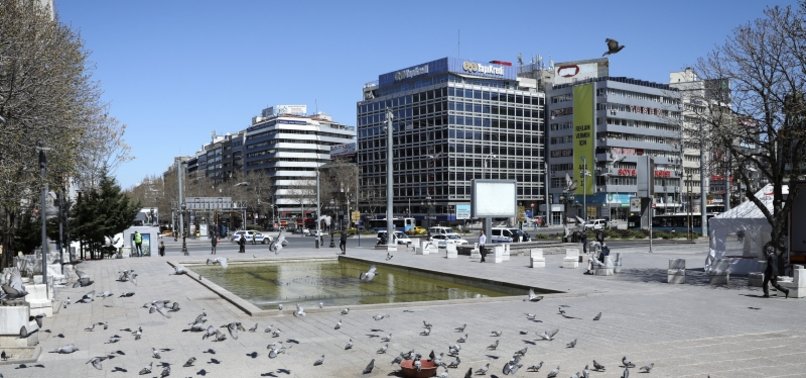(CNN) — Turkey may be famous for its kebabs, but the popular dish is just the tip of the iceberg when it comes to Turkish cuisine.
Covering over 300,000 square miles, the European destination’s rich and diverse food is largely thanks to its landscape.
Plateaus and plains of fertile soil formed by now extinct volcanoes, snow-covered mountains and fast-flowing rivers lend themselves to a rich and varied table.
This includes olive oil based dishes from the Mediterranean coast, hearty pastries from central Anatolia, subtle spicy flavors from the east and southeast, and that’s just for starters.
Traditional Turkish foods rely less on seasonings and more on tasty fresh ingredients rolled, kneaded, shaped and cooked to perfection with care, dedication and passion.
In fact, the Turks love their food so much they even write songs about it — “Domates, biber, patlican” by the famous Anatolian rock star Baris Manco translates to “Tomatoes, pepper, eggplant.”
Here are 23 top Turkish dishes beyond the basic kebab.
Piyaz
Antalya’s piyaz salad is one of the Turkish city’s most famous dishes — and its secret ingredient is its beans.
They’re not just any old butter bean, but a small version known as candir, named after the inland province where they’re grown.
Delicate and flavorful, candir are mixed, together with tahini thinned with a little water, lemon juice, vinegar, salt, garlic, flat-leaf parsley and olive oil.
In the very traditional version, a soft boiled egg is roughly chopped up and mixed through just before serving.
Ezogelin corba
Ezogelin soup was supposedly conjured up by a woman who wanted to impress her husband’s mother.
Shutterstock
According to legend, this dish was dreamed up by an unhappily married woman named Ezo who was trying to win over her mother-in-law via her stomach.
She concocted a zesty soup consisting of red lentils, domato salca (tomato paste — sweet or hot), grated fresh tomatoes and onions, served with dried mint and pul biber (chili flakes) sprinkled on top.
There’s no proof it actually worked, but just in case, ezogelin (which literally translates to bride Ezo), originating from a small village near Gaziantep, is still the food of choice for brides-to-be.
Saksuka
A traditional Turkish side dish, saksuka consists of eggplant, zucchinis, garlic, tomatoes and chili.
Shutterstock
Turkish cuisine incorporates a huge range of vegetable dishes known as zeytinyagli yemegi — foods cooked in olive oil.
The majority are vegetable-based and include green beans, artichokes and of course, eggplants.
One of the tastiest eggplant offerings is sasuka.
Here silky purple skinned cubes of green flesh are cooked with zucchinis, garlic, tomatoes and chilli — how much of the latter depending on where in Turkey it’s made.
Related content
Mac and cheese? Noodle soup? Top chefs share their go-to comfort foods
Kisir
This simple salad dish is made of fine bulgur wheat, tomatoes, garlic, parsley and mint.
Shutterstock
Kisir is a salad made from fine bulgur wheat, tomatoes, garlic, parsley and mint.
There are numerous versions from all over Turkey, but the Antakya one includes nar eksisi (sour pomegranate molasses) and pul biber (hot red chili flakes). They like it hot down south.
Mercimek kofte
Mercimek kofte is a hugely popular Turkish appetizer or side dish.
Shutterstock
Known to Diyarbakir locals as belluh, mercimek kofte is a vegetarian delight.
Made from red lentils, fine bulgur, salt, finely chopped onion, scallions, tomato and aci biber salca (hot red pepper paste) and crushed cilantro, they come in handy bite-sized servings.
Just pop one of these nuggets of flavor onto a lettuce leaf, add a squeeze of lemon juice, roll it up and munch away.
Yaprak dolma
This traditional dish is essentially vine leaves rolled and filled with either well-seasoned rice or mincemeat.
Shutterstock
In the Isparta version of yaprak dolma, rice is cooked with tomatoes, a bunch of parsley, onion, garlic, tomato paste, olive oil, black pepper, salt and water.
A spoonful of this mixture is placed on a vine leaf, folded in and carefully rolled by hand into neat little cylinders.
While leaves are sold at most street markets, the best ones come from a neighbor’s tree, usually picked at midnight.
Yaprak dolma are part of Turkish Aegean cuisine and sometimes include a pinch of cinnamon in the mix, a nod to the Rum people, Greeks born in Turkey.
Inegol kofte
Inegol Kofte — grilled meatballs made using ground beef or lamb, breadcrumbs and onions.
Shutterstock
Meatballs are so much more than just balls of meat in Turkish cuisine.
Each style brings its own unique serve of history. One of the best known is Inegol kofte, invented by one Mustafa Efendi.
Originally from Bulgaria, he migrated to Inegol in northwest Turkey in the 19th century.
Unlike other Turkish kofte his mix uses only ground beef or lamb and breadcrumbs, seasoned with onions.
Related content
Kebab city: How grilled meat makes sense of Istanbul’s chaos
Iskender kebab
Iskender kebab is named after İskender Efendi, the man who invented the dish.
Shutterstock
Located in northwest Turkey, Bursa is famous for three things — silk, the ski fields of Uludag and a type of kebab called Iskender.
Apparently a gentleman of the same name first cooked this dish for workers in the city’s Kayhan Bazaar back in 1867.
Thin slices of doner meat are reverently laid over pieces of plump pide bread, smothered in freshly made tomato sauce, baptized with a dash of sizzling melted butter and served with a portion of tangy yoghurt, grilled tomato and green peppers.
Cag kebab
To prepare this dish, marinated lamb meat is roasted on a horizontal rotating spit and cooked over a wood fire.
Shutterstock
The people of Erzurum take their meat very seriously. So much so, they’re prepared to wait more than 12 hours for a sliver of hot and tasty lamb cag kebab.
First the meat is smeared with a mix of onions, salt and black pepper and left to marinate for half a day.
Then it’s fed onto a long skewer and cooked horizontally over a wood fire.
Divine on its own, cag kebab is also served wrapped in flat lavas bread with slices of tomato, white onion and long thin green peppers called sivri.
Hamsili pilav
Hamsili pilav — an oven baked rice dish with a layer of fresh anchovies on top.
Shutterstock
Hamsi, aka European anchovy, is a staple in Turkish Black Sea kitchen. In the city of Rize, the slender fishes are prepared with rice to make Hamsili Pilav.
This dish is cooked in a stock made from fried onions, butter, peanuts, Turkish allspice and raisins, which is mixed with fresh parsley and dill.
Then filleted anchovies are arranged over the rice and the whole lot is cooked in the oven.
Perde pilav
Perde pilav — a buttery dough filled with rice, chicken, currants, almonds, pine nuts and butter.
Shutterstock
The town of Siirt is home to perde pilav, or curtain rice, a rice-based dish wrapped in a lush buttery dough, baked in an oven and served up hot.
Usually served at weddings, perde pilav is cooked with chicken, currants, almonds, pine nuts and butter, and seasoned with salt, oregano and pepper.
The shape of the dish is thought to represent the creation of a new home — the rice symbolizes fertility and the currants are for future children.
Manti
The most coveted version of these tasty Turkish dumplings are made in Kayseri, Central Anatolia.
Shutterstock
The most popular type of manti, small squares of dough with various fillings, are those made in Kayseri.
This central Anatolian version contains a spoonful of mince sealed into a small parcel, but they use cheese elsewhere.
The manti are dropped into boiling water and topped with yoghurt and pul biber (chili flakes).
Legend has it, a good Turkish housewife can make them so small that 40 fit onto one spoon.
Related content
Are the French becoming insecure about their cuisine?
Testi kebab
Testi kebab — a meat and vegetable dish that needs to be broken open before it’s eaten.
Shutterstock
This specialty of the Nevsehir region features pottery made in Avanos, using red clay from the famous Kizilirmak River.
First the clay jug is filled with beef, tomatoes, bell pepper, garlic and a knob of butter. Its opening is then sealed with a peeled slice of potato and covered in alfoil, before the jug is placed in a wood-burning oven.
Once the contents are ready, the cook must hold the alfoil covered top in one hand and a small hammer in the other to break open the meal.
The trick is to aim for the thin line circling the body of the vessel three quarters of the way up.
Gozleme
This traditional Turkish pastry is often stuffed with salty white cheese, minced beef or spinach.
Shutterstock
Alternatively known as sac boregi, pastry cooked on a sac, a hot convex metal plate, gozleme are flat savory pockets usually filled with salty white cheese, spinach or minced beef.
Although often considered village food, it takes expert handling to roll out the paper-thin dough without tearing it.
The word goz means “eye”, and the name gozleme is believed to come from the dark spots that form as the pastry cooks and absorbs the oil on the sac, forming “eyes.”
Pide
A type of flatbread made from stretched out dough balls stretched and inserted with a range of fillings.
Shutterstock
Pide are a firm favorite among Turks, with some of the tastiest originating in the Black Sea region.
Here dough balls are stretched out into an elongated base and loaded with a choice of fillings.
The most popular is sucuklu yumurta, spicy Turkish sausage and egg mixed with kasar (yellow sheep cheese) but ispanakli kasar, spinach with cheese, is equally good.
It’s the crust that makes pide a winner. Cooked in a wood-fired oven, the high temperature produces a crisp crunchy base ideal for all types of ingredients.
Su boregi
This savory pastry is made by layering sheets of a dough named “yufka” and adding a filling of white cheese.
Shutterstock
Borek, a savory pastry made from layering sheets of a fine filo-like dough called yufka, is a staple of the high plateaus of central Anatolia.
It was brought to Turkey by nomadic herders hundreds of years ago, and different varieties can be found all over the country and throughout Central and Eastern Europe.
Su boregi, meaning “water borek” is the most commonly available, relying on white cheese, butter, olive oil and salt for flavor.
Related content
The world’s 50 best foods
Simit
If a country can be said to run on its stomach, simit is the fuel that keeps Turkey going.
They’re sold everywhere, by street vendors carrying baskets or pushing carts, in bakeries and cafes, at tram, train and metro stations and even on ferries.
It’s believed simit were created in the palace kitchens of Suleyman the Magnificent in the 1500s, but no official records exist.
In October 2019, the word simit was officially recognized by the Oxford English Dictionary and the rest, as they say, is history.
Lahmacun
Lahmacun is commonly referred to as Turkish Pizza.
Shutterstock
According to Ottoman explorer Evliya Celebi, who roamed far and wide in the 17th century, lahmacun takes its name from the Arabic word lahm-i acinli.
It’s a type of pastry made from lahm, meat in Arabic and ajin, paste.
The paste consists of low fat mince mixed with tomato paste, garlic and spices smeared on a thin round of pita dough and can be made spicier on request.
Served with fresh parsley and a squeeze of lemon juice, Turks have been eating this dish for more than 300 years.
Cig kofte
Cig kofte — a raw meatball dish in which the meat is usually substituted with bulgur and/or ground walnuts.
Shutterstock
Cig kofte originates from Sanliurfa, taking its name from the original recipe using raw (cig) ground beef, combined with bulgur, tomato paste, onions garlic, pepper and Turkish spices.
The mix was kneaded until it was declared ready, determined by throwing a piece up to the ceiling. When it stuck there it was done.
These days the meat has been wholly replaced by bulgur and sometimes ground walnuts, making for a healthier, but equally tasty choice.
Baklava
The people of Gaziantep, also known as Antep, in Turkey’s Southeastern Anatolia Region, know the best baklava is made in a darkened room with a controlled temperature perfect for stacking the 40 sheets of tissue-like pastry that go into this Turkish culinary icon.
First each sheet is brushed with butter, and ground pistachios are sprinkled over every few layers. Then a honeyed syrup is poured over the contents, and the pastry is baked until golden.
Different versions have enticing names such as twisted turban, nightingale’s nest, saray or palace baklava, and are all equally irresistible.
Baklava can be enjoyed plain or with a dollop of kaymak, Turkey’s answer to clotted cream.
Related content
Romania on a platter: The new Romanian cuisine you need to experience
Dondurma
Dondurma is made from milk and sahlep, a flour made from the tubers of orchids, and mastic.
Shutterstock
Where can you find ice cream you can eat with a knife and fork?
In Kahramanmaras, home of traditional Turkish dondurma, of course. Traditional dondurma (which means freezing in Turkish) is made from milk and two special ingredients, sahlep and mastic.
Sahlep is a type of flour produced from orchids that provides a smooth velvety finish to the ice cream, while the mastic, a natural gum, adds a unique chewiness.
Lokum
Also known as Turkish Delight, Lokum dates back centuries.
Shutterstock
Lokum, known in English as Turkish Delight, dates back centuries. However, it wasn’t until the mid-19th century that it became a hit with the Ottoman sultans.
That’s when corn starch was invented and Istanbul confectioner Haci Bekir added it to the list of ingredients.
This simple combination of water, starch and sugar, boiled together to produce delicate cubes flavored with rose water, pistachio and other flavors continues to delight.
Ekmek kadayifi
This Afyonkarahisar dessert is made from a special type of dehydrated bread with a consistency similar to crumpets.
The bread is placed on a large tray and steeped in water to make it expand. Then it’s covered in a syrup made of sugar, water and lemon and simmered on the stove.
The syrup is constantly spooned back over the bread to infuse it with a sweet sticky texture.
When read, it’s turned upside down onto a serving dish and eaten with kaymak, thick Turkish cream.








